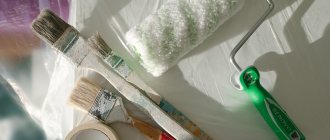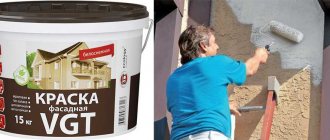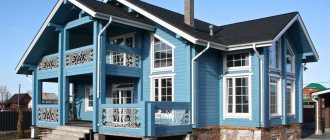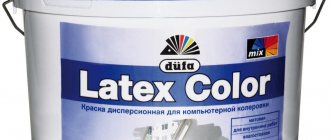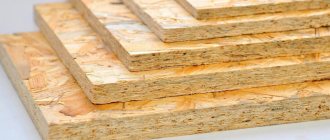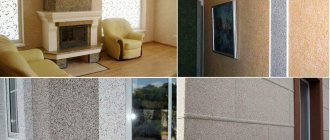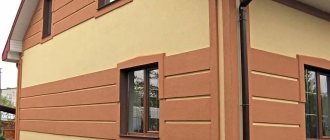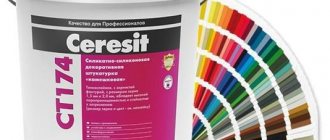What is OSB board for facade?
OSB board is an abbreviation for the English phrase Orient Stand Board, which means “oriented strand board”.
Based on the name, it would be more logical to call the material OSB, but in construction the name OSB has taken root.
It is OSB pressed shavings of wood of various species. To create such a material, coniferous wood is crushed into chips or shavings, after which it is molded on special equipment, laid out in three layers.
Each layer is located in a certain direction: the inner layers of the slab are located transversely, and the outer layers are located longitudinally. That is why the slab is called “oriented”.
After laying out, the wood material is sent under the press. The gluing process is carried out using resins and various waxes, which provide the material with the necessary level of water resistance.
Features of OSB boards
Production of OSB boards
Oriented strand boards (OSB) consist of several layers of chips and shavings pressed and glued together. A feature of the manufacturing technology of these types of panels is that the chips in the layers are located in different directions. This provides the material with high bending strength and allows it to securely hold the fastener. On the outer layers of the panel, the chips are located along the surface, on the inner layers - across.
Classification of OSB boards
But despite the longitudinal direction of the wood component, the front side of the panel does not have the smoothness necessary for high-quality painting. Both sides of the OSB board are uneven and rough. This feature has its pros and cons. The advantage is that the lack of smoothness allows you to get a surface with a spectacular texture. The disadvantage is the need for additional processing of the slab with various tools and materials.
The market offers several brands of oriented strand panels: OSB-1, OSB-2, OSB-3 and OSB-4. The latter are intended for front finishing and have a fairly smooth and effective surface. But in the construction of frame houses, OSB-3 is most often used, since it is cheaper and has all the necessary characteristics for constructing walls. However, the surface of OSB-3 boards needs to be improved.
OSB - oriented strand boards
Since this material is most popular among developers, all the finishing methods proposed below take into account the peculiarities of the surface of these panels and can be applied to products of other brands: OSB-1 and OSB-2.
Prices for OSB (oriented strand boards)
OSB (oriented strand board)
How to paint an OSB board outside on the street?
Coloring methods
Since OSB board consists of wood, any material intended for facade work on wood can be used for its processing: impregnations, facade paints and enamels.
It is necessary to choose a finishing material depending on the desired effect.
When using pigmented materials, the texture of the OSB board is painted over, and the result is a dense, continuous and colored coating.
The use of colorless materials involves emphasizing and enhancing the expression of the texture of the slab.
When using facade paint as a material for processing OSB, you need to know about some nuances of the work:
- sharp corners of the slab can cause cracking of any coating, so work should begin by sanding these areas;
- the edges of the slab are characterized by a higher degree of porosity than the rest of the surface, so these areas require a number of sealing measures;
- to reduce water absorption properties and increase the degree of adhesion, it is necessary to pre-prime the slabs;
- The dyeing process requires multi-layer application of dye, so each layer must be made as thin as possible.
Well-known manufacturers of OSB paint
To make it easier for you to find a specific drug or at least its manufacturer, we will consider the highest quality and well-known brands on the building materials market. We specially selected Russian and foreign samples in order to cover the interests of the widest possible readership. So let's get started.
The table does not list everything, but only the most popular well-known brands. Of course, every master has his own secret set of paints and primers, which not everyone is willing to share. We don’t keep anything secret and are happy to tell you all the intricacies of working with modern construction chemicals.
If you are not a professional builder, and your work with OSB boards can be considered sporadic, you do not want to delve deeply into the properties and subtleties of choosing paints, you do not have to solve a serious problem - then the easiest way is to purchase a universal compound for working with plywood, such as GOODHIM F01 M1.
What kind of paint
Alkyd, acrylic facade and oil paints. Of all the existing facade paints suitable for finishing OSB, we can highlight:
- Alkyd. This dye is based on alkyd resins, which are made by boiling a mixture of acids and vegetable oils. After application, the paint forms a thin film, which will subsequently protect the surface from moisture penetration. They are characterized by low cost. The material is resistant to ultraviolet radiation and low temperatures. The paint dries in just 10 hours, and it is completely non-toxic. The drying process of the dye is accompanied by unpleasant odors. Application of an alkyd composition requires careful preparation of the surface, otherwise the paint will begin to form bubbles and peel off. After surface treatment, OSB panels retain the ability to ignite.
- Acrylic. Acrylic paints are based on water, and acrylates act as a binder. After applying the dye to the surface, the water evaporates, which contributes to the formation of a durable polymer layer. This type of coating provides OSB boards with a high degree of resistance to moisture, negative temperatures and ultraviolet radiation. Thanks to the water-based paints, the material treated with them becomes fire-resistant.
- Oily. The basis of such paints is drying oil. In practice, oil dyes are rarely used, since many more practical materials are available on the modern construction market. Paints are highly toxic, so all coating work must be carried out using a respirator. They are distinguished by their high cost, as they are made from expensive raw materials. During use, smudges often form. It takes at least a day to dry completely. The coating is not durable, since oil paints are highly susceptible to the negative effects of external factors, and with prolonged use, the dye layer begins to crack.
Method of application of compositions
The slabs consist of pressed and glued wood chips. Both surfaces do not have the required smoothness for applying paints and varnishes - they are rough. This feature gives it a special texture, but painting or wallpapering will require surface treatment of the building material.
Manufacturers produce several models of panels. 1;2 for front finishing and 3;4 for frame construction. The second option is cheaper, has the appropriate characteristics, but its use requires thorough processing.
Covering enamels
Before painting an OSB board on the street or in the house, you need to determine the types of enamels and paints that hide the protrusions of the chips.
Floor slabs covered with enamel Source pinimg.com
Among them, the following options are offered:
- Latex . High level of moisture resistance, an excellent option for buildings located near water. Good covering ability. Not demanding on the surface condition. Facade paints can withstand many freezing cycles.
Latex paint Source gidkaminov.ru
- Water soluble . It is considered the best option: inexpensive, withstands temperature changes, the influence of moisture and sun, and allows air to pass through. Can be used in winter. Do not use at temperatures of 20 degrees below zero. Such paints are also called acrylic.
Acrylic paint Source static.tildacdn.com
- Pentaphthalic . They have a high level of viscosity and adhesion, forming a smooth and dense surface. They practically do not absorb moisture. Small expense. It takes a long time to dry, not for outdoor use. Instability to the influence of sun and moisture.
Pentaphthalic paint options Source farbagroup.com.ua
- Alkyd . They have all the characteristics for facades. Forms a moisture-resistant film. The color does not change under the influence of ultraviolet radiation. They can withstand large temperature changes for any region of the country.
Alkyd paint Source gidpokraske.ru
- Silicone . Dear ones, they fully meet the requirements for facades. Resistant to mechanical action, moisture and cracking. Used for slabs that have previously been whitewashed or painted.
Silicone paint Source caparol161.ru
So, it’s up to you to choose how to cover an OSB board indoors. Consider the performance and aesthetics you want. It is not recommended to use water-dispersed formulations. They contain a lot of water, which can deform the slabs.
Tinting
Stain makes it possible to emphasize the texture of wood. The required shade is obtained by adding acetone, solvent or water. The diluted stain dries within 5-10 minutes. The stain preserves the natural grain of the wood and protects it from the sun and moisture. Apply with a spray gun/brush. A layer of polyurethane primer is applied on top.
To achieve an aging effect, patina of any color will be used. When the patina has dried, sanding with a soft sponge is carried out to remove any remaining material. After this, the panel must be coated with transparent varnish.
Artificial aging Source pinimg.com
Transparent coatings
How to paint an OSB board to preserve the texture: for this purpose, special transparent compounds with a UV filter, water repellents and stabilizers based on alkyd resins are used. Can be used outside, providing protection from the negative influence of the environment.
Plates with transparent coating Source teremforum.ru
You can preserve the natural appearance of the slabs using the following compositions:
- impregnation – provide good protection of the material;
- glazes are the most effective, they preserve the design and add shine;
- varnishes – provide gloss, protect from moisture, and give a special shade.
In some cases, slabs can be varnished in several layers. The process is long because the material takes a long time to dry. But this allows you to get a fairly strong, durable and reliable coating that will thoroughly protect the wood.
Fire protection
When OSB burns, harmful substances are released, the smoke becomes very dangerous even with a small fire. At the same time, you can increase the fire protection and paint the surface with Soppka paint. It is designed for such slabs, has high adhesion, lasts more than 15 years and can withstand various negative influences.
Fire protection for OSB boards Source diymall.co
OSB can be painted with various specially developed paints. They allow you to give an aesthetic appearance, extend the service life of the panel and increase fire resistance properties. Enamels have a high covering ability, do not change color over time, and protect against rot.
Is latex paint suitable?
Latex paints are a water-based type of dye in which the binder is latex (rubber).
The cost of this material is much higher than others, but the costs are more than offset by its unique properties and quality of coating.
A distinctive feature of the paint and varnish material is its excellent elasticity - the coating does not deform even if the base is destroyed.
The mechanical impact of such a material is also not dangerous; facade paint on wood completely insulates OSB boards from moisture and provides them with a high level of sealing.
In addition, the treated surface becomes resistant to atmospheric agents, so the average lifespan of such a coating is ten years.
Latex paints are characterized by a high level of environmental friendliness, so there are no unpleasant odors during coating.
You can clean the surface using household chemicals.
Features of the material influencing the choice of paint
OSB boards can be called a specific material due to the pronounced texture of individual chips on the surface and some other features.
Before you start choosing a particular type of paint, consider the following points:
- Without preliminary surface treatment, the paint may adhere poorly or unevenly to the base. This occurs due to poor adhesion or because the slabs are treated with special impregnations, which in turn form a film on the surface;
- It is not recommended to choose water-based compositions due to the fact that excess moisture can lead to swelling of the surface;
- A rough surface will require more paint;
- If the slabs are poorly painted even after careful preparation, it means they were stored incorrectly. Material that has been lying outside for more than one year must be thoroughly cleaned of dust and other contaminants, sanded and treated with antiseptics;
- At the ends, the slabs have a more porous structure; accordingly, they will require more paint to fill the voids. To avoid excessive consumption, it is recommended to pre-treat the seams.
Preparation
What to putty on before painting?
It is necessary to choose a putty for OSB boards from a range of compounds intended for finishing wooden bases, as well as having an adhesive, oil or synthetic base.
Mixtures for concrete or brick most likely will not last long on OSB.
Experts consider the following to be the most suitable for OSB boards:
- special acrylic putties for OSB, also intended for leveling wooden and wood-shaving substrates;
- nitro putties ASh-24/32 and MBSh - they are made from cellulose ethers and resins with various plasticizing additives and fillers (to obtain the desired consistency they can be diluted using solvents);
- oil-adhesive putties based on drying oil, varnishes and glue with the addition of thickeners, chalk and modifying additives (diluted with drying oil).
Regardless of the composition, putty for OSB should have the following properties:
- good adhesion to smooth, resin-coated substrates;
- low degree of shrinkage upon drying with minimal likelihood of cracking;
- high durability of the coating and its suitability for decorative finishing;
- no solid fillers in the mixture, homogeneous consistency.
To avoid the appearance of cracks during OSB finishing, experts strongly recommend reinforcing the panels using elastic materials.
The most common option is reinforcement using repair (painting) non-woven fabric.
To glue it, you will need glue for the appropriate type of wall covering.
Primer
Before filling the OSB board, the surface must first be prepared: sanded and primed.
Experts recommend using slabs that have already been sanded by the manufacturer - their cost is not much higher, and it takes much less effort and time to finish such material.
The choice of primer, like putty, should be one that is intended for treating wooden surfaces and does not contain water. Compositions based on drying oil or glyphthalic varnish are ideal.
The ends of OSB boards have the greatest water absorption capacity, so they should be treated with a primer before installing the sheets, since this will be impossible to do later.
OSB painting with artificial aging effect
This method of processing OSB panels allows you to preserve the surface texture while smoothing out the most noticeable chip protrusions. The end result is a smooth slab, on which its natural pattern is clearly visible. Using multi-layer dyeing with compositions of different colors and purposes, they provide two stylish effects at once: colored dyeing and artificial aging.
Tools and materials that will be required to complete the work.
- Angle grinder (grinder).
- Abrasive grinding wheels of different grain sizes: P180 and P320. You can use modern abrasive Velcro tapes, one side of which is self-adhesive.
- Abrasive sponge P320.
Abrasive sponge fine grain P 280-P320
- Airbrush or spray gun.
- Primers: FI M194 and FL M042/CO2.
Primer FL-M042/C02 Renner
- Acrylic varnish “Mother of Pearl” JW M120.
- Tinted varnish JO 00M294.
- Patina GM M048/Black.
Stages of painting OSB boards
Step 1: Sanding the panel.
Smooth out uneven surfaces of the panel using a grinder and a P180 grinding wheel. To obtain the desired result, work with light pressure from the tool. The panels are passed over each section with an abrasive wheel no more than three times.
Sanding OSB
Step 2: Apply the first coat of primer.
OSB boards are made using a special adhesive impregnation, which includes various resins, wax and paraffin. These substances are necessary to prevent the panel from delaminating and the formation of rot and mold in it.
Primer for OSB
Applying primer
A primer on the sanded OSB surface is needed to ensure that the resins and paraffin continue to remain inside the slab. At this stage of work, barrier primer FI M194 is used. It is applied using an airbrush or spray gun. Material consumption is within 50-60 g/m2. Further work begins after 1.5-2 hours, after the soil has completely dried.
Step 3. Applying pigment primer.
At this stage of the work, the panel is covered with primer FL M042/CO2. This is a matte white composition that dries within 2.5-3 hours. The soil consumption should be at least 100 g/m2.
Step 4: Sanding the slab.
Use a grinder with a P320 abrasive wheel. Only the top layer of pigment primer is removed. The result should be a smooth whitish matte surface.
Primed surface
Step 5. Varnishing the slab.
Acrylic varnish “Pearl” JW M120 is applied to the OSB so that the weight of the wet layer is 100-120 g/m2. In order to achieve this result, each section of the panel must be covered with 2-3 layers of varnish. Then wait for the coating to dry completely for an hour.
Step 6. Patination.
At this stage of work, black patina GM M048 is applied to the panel. As before, an airbrush or spray gun is used for this purpose. The weight of the wet layer should be 60-80 g/m2. There should be no gaps in the panel from the previous white layer. The patina dries within 5-7 minutes.
Patina for wood Renner GM M048/C01
Step 7. Patina sanding.
Using light pressure, sand the panel with a P320 abrasive sponge. After such processing, you should get a surface with a clear chip pattern, the main part of which is white, and the spaces between the chips are black. This provides an artificial aging effect.
Remove excess patina with a sponge
Step 8. Tinting the OSB board.
Tinting is the stage as a result of which the slab acquires color. To perform this task, acrylic varnish is used. The color is chosen depending on how you want the facade of your house to look. Varnish consumption is within 100-120 g/m2. Drying time according to the manufacturer's instructions, but on average 1.5-2 hours.
Acrylic lacquer
It should be noted that as the varnish dries, its color will change due to the gradual acquisition of dullness. This example uses JO 00M294 zero gloss varnish. If you want to give the façade of your home a glossy look, you can opt for compounds that provide this effect.
Example of applying varnish with a brush
Technology for painting OSB boards: instructions and video
What are the dyeing techniques?
When applying paint to OSB with a roller or brush, you may notice that some individual chips swell from moisture and rise.
This happens regardless of the type of material chosen. If you need budget finishing of the facade, then you can ignore these minor shortcomings.
However, if you need to complete all the finishing work as efficiently as possible, you should adhere to the following sequence of actions:
- priming the slab;
- installation of fiberglass mesh over the entire façade area;
- filling the surface with a frost-resistant and moisture-resistant composition;
- coloring.
When choosing elastic dyes, you can skip the puttying step - such paints will fit perfectly onto the fiberglass mesh and disguise it.
After applying the second layer, the OSB board will acquire a completely smooth and glossy surface.
The principles of preparing and painting OSB boards can be found here:
Preparing OSB boards for painting
OSB requires preparation before painting
Before painting, the oriented strand panels are prepared. First of all, they need to be primed. This is not as simple a task as it might seem at first glance. The fact is that the front surface of the new slabs is smooth and quite slippery, so the primer will collect in drops and flow down. For this reason, experts recommend not to waste time and money on priming new slabs, but to immediately begin filling or painting them.
Panels that have stood in the open air for some time lose the smoothness of their front side. The surface becomes rough and able to absorb primer. The composition is applied with a roller on a long handle. The optimal choice is the Ceresit ST17 primer, the quality of which has been tested by time.
Primer ST 17
Prices for Ceresit primer
Primer Ceresit
How to apply paint correctly
To obtain a uniform and high-quality coating, experienced craftsmen recommend adhering to the following algorithm of actions when applying paint:
- painting the perimeter of the slab - the edges should be painted in two or three layers, and then, using a roller, distribute the paint over the rest of the surface;
- applying the composition to the unsanded side of the slab - the layer should be as thin as possible (paint should be applied in one direction);
- drying painted slabs - in this case, sudden changes in temperature and the formation of drafts should not be allowed (the approximate drying time for the first layer is 8 hours);
- applying a second layer of paint, taking into account masking or enhancing the OSB texture.
How to paint OSB
Before painting, you need to select a dye, the necessary tools, and carefully prepare the surface. This will reduce material consumption and facilitate the application process.
Required Tools
Tools for applying paint are selected depending on the viscosity of the paint, its texture and absorbency. Painting compositions can be applied with a roller, wide brush, airbrush or spray gun.
To prepare the surface for painting, you must have a grinding machine (grinder), abrasive grinding wheels of different grain sizes, and a low-abrasive sponge.
Surface preparation
All preparatory work is carried out after the installation of the slab structure, since after installation it is still necessary to adjust the joints and sand down any irregularities.
Grinding
In order for OSB to be smooth and even, it must first be sanded with a grinding machine with an attachment made of sandpaper of various abrasiveness. You can use a medium-grit sandpaper attachment. For very rough areas, first use coarse-grained sandpaper, and then fine-grained sandpaper. Careful sanding is needed when the surface is to be covered with stain.
OSB-3 and OSB-4 boards are sanded especially deeply, since the protective varnish and wax coating must be removed from them.
Purging
After sanding, the joints of the plates must be blown out with a compressor with a thin long hose. The procedure will remove sanding dust or possible dirt residues in hard-to-reach places. If there is no compressor, it can be replaced with a long-haired brush.
putty
OSB of any type always has small irregularities and depressions that need to be puttied. The putty must have an oil-adhesive composition. It fills voids and dents from self-tapping screws. Afterwards, the slabs are additionally sanded, but not earlier than 1-2 days after puttying.
It is not recommended to putty OSB at the joints and along the seams, since it will not be possible to disguise them, and after painting these areas will still be visible.
To disguise the seams, it is better to use decorative strips, and initially install the sheets not chaotically, but in a certain order. Sometimes, to putty joints more than 5 mm wide, mixtures with sawdust are used, which are added immediately before puttying. Sawdust should make up a quarter of the total volume of putty materials. They also use sealants and elastic bands.
Primer
It is best to prime OSB with acrylic or acrylic-polyurethane water-based varnish. The composition must first be diluted with water in a ratio of 1 to 10. Alkyd varnish can also be diluted with white spirit. Apply the composition carefully and slowly so that it is well absorbed into the surface.
You can prime with an adhesive primer like Aqua-filler or its analogues. This option is suitable when subsequent application of light-colored paint is expected. Adhesive primer protects the surface from the appearance of resinous stains and traces of essential oils. This is true if the slabs are made of coniferous wood, saturated with natural resins, which often appear on the surface of the painted layer.
Additionally, the façade of the building can be coated with protective solutions against fungus, rot, mold, for water repellency or against fire. To save your budget, you can use universal complex products that include 3 protective emulsions at once.
Painting process
- Paint is applied with a brush along the perimeter of the OSB. A thicker layer is applied along the edges, since it is absorbed more in this area.
- The paint composition is distributed with a roller over the entire slab in an even layer. The surface must be painted in one direction. It is necessary to especially carefully monitor the uniform application of the composition when using water-dispersed solutions, since they can provoke swelling of the slabs and uneven deformation.
- The slabs are thoroughly dried. When working indoors, avoid drafts or temperature changes.
- After the first layer has dried, the second is applied. This time the direction of movement of the roller should be perpendicular to the previous layer. The period between applying two layers should be at least 8 hours.
- You can apply layers of other paints.
If you intend to tint OSB with stain, you must perform the following steps.
- If necessary, the stain is diluted with a solvent or acetone.
- Apply stain to the slab with a paint brush, spray gun, or rub in with a foam swab (rag).
- Allow the composition to dry thoroughly. This will take no more than 10 minutes.
- The dried stain-painted surface must be fixed with polyurethane primer and wait for it to dry completely.
To give the effect of aging, a patina of the desired shade is applied. After its application and complete drying, the OSB is sanded with a soft foam sponge. This way, unnecessary patina remains are removed. As a finishing layer, a layer of clear varnish is applied to the sanded patina.
Where to buy paint for facades made of OSB panels?
In Moscow
In Moscow, facade paint for OSB boards can be purchased in stores such as:
- "Oliva": official website: https://oliva.ru;
- address: Moscow, 2nd Kabelnaya street, building 2, building 50;
- telephone.
- official website: https://ooodeltakom.ru;
- official website: https://www.bazis-prom.ru;
Types of impregnation
Plates of categories 3 and 4 initially characterized by high moisture resistance Water repellents are added to the raw materials. OSB 2 and 3 are still recommended to be treated additionally with special means, especially in rainy regions.
Colorless impregnations
The simplest and cheapest option is colorless impregnation. The product penetrates the outer layer of the material and forms a water-repellent layer. Does not affect appearance.
The compositions are suitable different. Most often silicone-based mixtures , as they create a vapor-permeable layer. Impregnation based on organosilicon polymers . It reduces the water absorption of OSB by 15 times.
Alkyd, water and oil based varnishes
You can paint OSB with transparent or colored varnish. They use mixtures for exterior use, based on alkyd-urethane. The varnish forms a thin waterproof film on the surface of the slab. In addition, it protects the material from ultraviolet radiation and has an antibacterial effect.
Oil-based varnish is also used. It has a thicker and more viscous consistency, permeating the material.
Oil-wax impregnations
A coating based on natural oil, but with the addition of wax, usually beeswax. The composition provides a soft honey shade and shine. The coating is waterproof. The resistance to dampness of the material increases 10 times.
stain
OSB can be painted with stain. The composition gives the panel different shades, emphasizes the structure, making the relationship of tones more contrasting. The stain dries in 10–15 minutes. The longer it is used, the darker the wood becomes.
To ensure that this treatment protects against moisture, the slabs are coated with a polyurethane primer after treatment.
Covering compounds
Sometimes it is undesirable to emphasize the OSB structure, since its beauty is questionable. In such cases, the material is coated with compounds with high covering ability. Paint for OSB boards has a dense structure and is highly waterproof.
- Acrylic - water-based composition, but with a polymer binder. This coating is breathable, odorless, and tolerates both heat and cold down to -20°C.
- Latex - characterized by high hiding power and water resistance. The base paint can be tinted in different shades.
- PF enamels are completely opaque viscous compositions. They form a very dense mechanically resistant layer on the surface. Enamels take a long time to dry, but they also last a long time.
- Alkyd - attract due to the brightness and variety of shades. They do not fade in the sun and are suitable even for interior work.
- Silicone - paint is applied to a layer of primer. After drying, silicone paint forms a dense, water-impermeable layer.
To paint OSB panels on the outside, it is recommended to use silicone and latex compounds.
Coloring
Since OSB is a wood processing product, the same paints and varnishes can be used for them:
- Oil paints. Due to the presence of polymer resins in OSB, drying oil-based paints do not always adhere well to the surface being painted. For better adhesion to the base, it is recommended to perform double priming with intermediate putty before painting. Despite this, oil-based coatings under the influence of ultraviolet radiation, temperature changes and precipitation are prone to fading, cracking, and even peeling. We can recommend paint based on natural and modified oil PINOTEX WOOD OIL SPRAY, which has good resistance to external factors.
- Alkyd paints are better suited to particle boards because they contain alkyd resin, a product of the chemical reaction of natural oils with acids. Their adhesion is higher compared to oil-based paints, they dry faster and resist atmospheric influences more successfully.
- Acrylic compositions, being inexpensive and durable to use, have an optimal balance of qualities and are most in demand for painting wood. In addition, they are available in a wide range of colors.
Attention: pre-treat a small surface in an inconspicuous place to ensure that the material does not swell when exposed to the aqueous acrylic suspension.
In conclusion, we can say that the question: how to treat OSB boards against moisture is difficult to answer unequivocally. Firstly: it depends on whether you want to emphasize the texture of the slab with a transparent solution or, conversely, apply a covering (opaque) coating. Secondly: – on the financial capabilities and aesthetic ideas of the developer.
Is additional processing needed?
The moisture resistance of oriented strand boards is characterized by the amount of thickness swelling during the day. According to this parameter, according to the American standard PS 2, European EN-300 and Russian GOST 10632-89, slabs are divided into 4 types (see table).
| Swelling value in thickness over 24 hours, % | |
| OSB-1 | 25 |
| OSB-2 | 20 |
| OSB-3 | 15 |
| OSB-4 | 12 |
Let us remind you that for the external cladding of a building it is allowed to use only OSB-3 and OSB-4 boards.
If the constructed structure is to be finished somehow, then during construction the OSB boards lie on the construction site in bundles. Even after one rain, the top few sheets swell almost one and a half times. They will remain like this after drying. The remaining sheets swell at the ends. By the way, to avoid this, the ends of North American products are painted with blood-red impregnation.
There is an opinion among some builders that OSB boards do not require additional processing, since they are already impregnated with resins, waxed, and varnished. Experience shows that after 2-3 years their appearance loses its original freshness, they darken, individual chips bulge here and there, and joints protrude sloppily.
Therefore, additional hydrophobic treatment will not be superfluous, especially if it is the facade of a residential building without any cladding. Let's consider how to treat OSB boards from moisture.
Caring for painted OSB
With the correct choice of decorative composition and compliance with the preparation and application technology, further procedures will be as follows:
- After 5-7 years (depending on the composition), a light treatment with a thin layer of diluted solution can be performed to revitalize the surface.
- Significant difficulties arise due to the shrinkage of the house; more serious reconstruction may be required. But if the frame was positioned accurately, observing the gaps, then you will only need to rearrange the moldings on the outside and minor finishing work on the inside, followed by painting in the desired color.
- Worn flooring is re-sanded and varnished.
Painting OSB is not the most difficult process, requiring accuracy and a precise sequence of all actions to obtain a high-quality result.
Examples of paint and primer selection. Stamps
In order not to carry out experiments, wondering how to paint the OSB board on the outside and what primer the paint will be combined with, it is easier to make a choice in favor of those options that have already been tested and really work when finishing is done. This will save time and money and ensure durability.
Combining a primer called “Aqua Primer-3130” with a paint called “Aquatop-2920 – 04” brings good results. For a dense and high-quality decorative finish, only 2 layers of paint composition are required. The result is a smooth, waterproof surface with high protection from ultraviolet rays. Detergents can be used for cleaning later.
There is a more economical way to successfully combine colors. Namely, a primer called “Teknol-2881” together with a paint called “Nordica Eco-3330”. This combination, according to its own parameters, is not much different from the previous one, but is not very well able to withstand the negative effects of household chemicals.
Choosing a composition for external and internal finishing of OSB boards
In order to paint OSB with high quality with your own hands, you need to take a responsible approach to choosing the mixture.
Dye
Several types of material can be used.
One of the simplest and most popular solutions, the composition provides fairly high adhesion to the surface of OSB panels. Traditional options:
- Oily. Coloring with such mixtures is widespread, although in recent years it has been declining. This is explained by the fact that the products are quite toxic and have a pungent odor. The resulting coating has a service life of 3–5 years, after which it fades and loses its decorative qualities.
Alkyd enamel is usually used for exterior work because it is not environmentally friendly and has a toxic odor.
The most modern products with high aesthetic and performance qualities. For processing OSB, compositions with a polymer component are used. This list includes:
- Acrylic. The mixtures are absolutely safe, UV resistant and easy to apply. When working with particle boards, water-based compositions require high-quality priming and application of the solution in thin layers. It is necessary to prevent excessive moisture absorption, otherwise the panel may swell.
Latex paints have excellent moisture resistance, but are expensive
A separate category of products with a wide range of applications. This option can be used as a base or play an independent role as a finishing coating. Special mixtures are produced for working with OSB.
On a note! When choosing a composition for different processes, it is better to give preference to certain categories, even taking into account the fact that many mixtures are universal. This is especially true for facade work, so in such a situation it is advisable to purchase special solutions.
Primer
Due to the fact that OSB-3 boards, which have low adhesion due to additional treatment against moisture penetration, are most often used for cladding interior structures of premises and facades, priming is a mandatory procedure. In addition, this significantly reduces paint consumption and reduces the likelihood of deformation when choosing water-based compositions.
The following varieties are suitable for this work:
- Drying oil. This is a simple solution if you plan to use oil paints.
Concrete contact primer is used to ensure maximum adhesion of paint to the OSB surface
After laying and drying any type of soil, it is necessary to quickly treat the base with decorative or protective materials. During this period, adhesion is maximum.
Impregnation
The following varieties are used:
- Stain. Like drying oil, it helps protect the material from the harmful effects of water, preventing rotting. Although the outside of the building is sheathed with moisture-resistant products of classes 3 and 4, OSB-2 boards are most often found inside; they are processed separately. Stain is also applied as a decorative layer when covering panels with varnish.
Universal deep-penetrating antiseptic
Important! Particular attention must be paid to the ends of parts located outdoors. They are impregnated more thoroughly, since it is in these places that destruction begins, caused by the harmful effects of the environment.
This composition is more suitable for indoor work. For floors or ceilings, colorless varnish is more often used to ensure the preservation of the natural appearance of the material. To enhance the ambience, well-defined wood chips can be treated with a stain of a suitable color, which is not just applied, but literally shaded.
To convey the texture of natural wood, colored varnishes are chosen. But the structure of the panel is extremely heterogeneous, so obtaining a uniform coating will not be so easy, regardless of the chosen paint and varnish mixture. The desired result can be achieved by painting the base 3 to 6 times.
Methods for finishing OSB facades
OSB boards, which are made by pressing wood chips, are not the easiest material for facade finishing. The chips in the two outer layers of the board are perpendicular to the chips in the inner layer, and although all layers are impregnated with glue, OSB is considered a material that is not resistant to weathering and ultraviolet radiation.
But, despite the fact that the debate on the topic “is it possible to make external cladding of a house from OSB” still does not cease, many FORUMHOUSE participants believe that “this game is worth the candle”: in terms of speed, ease of installation, and especially - low cost of such a facade.
And, as practice has shown, if moisture-resistant OSB-3 (or OSB-4) is used for facade work, then all the horror stories about “swelling” are completely refuted by time. Under one condition - that such a facade will be closed (“protected”) from the effects of external unfavorable conditions as quickly as possible.
BirdofpreyForumHouse Member
If you want to throw away money, then you can use OSB as a finish, and a complete one at that.
OSB is a moisture-resistant material, that is, it tolerates high air humidity without changing its physical and mechanical properties. But, like any material made from untreated wood, it absorbs water when directly exposed. Such a facade should be closed in the very near future, says our expert, head of the SOPPKA project, Artem Vladimirovich Solovyov.
Artem Vladimirovich SolovyovHead of the SOPPKA project
Having extensive experience, high-quality feedback from our clients, as well as recommendations from OSB manufacturing plants, we can say with confidence that leaving the slab outdoors for more than 1-2 months will have the most negative impact on it.
How long a slab can remain outdoors without protection or finishing without losing its performance depends on weather conditions, but with regular interaction with water it will inevitably change its physical and mechanical properties. Also, the slab is exposed to ultraviolet radiation; under the sun it darkens, the binding resins burn out, and the top layer of wood chips begins to peel off.
Soloviev Artem Vladimirovich
We do not recommend leaving OSB unprotected over the winter. If the stove has been used in atmospheric conditions for more than a year, it must be restored because:
- the destruction of the top layer of the slab began;
- The stove, due to moisture, may be affected by fungus.
OSB consists of 90% wood, so for finishing the facade made of OSB or SIP panels, you can use the same materials as for wooden house construction.
The most popular finishing options for such facades include:
- siding;
- fake diamond;
- clinker tiles;
- ceramic tiles imitating brick;
- decorative plaster;
- painting.
